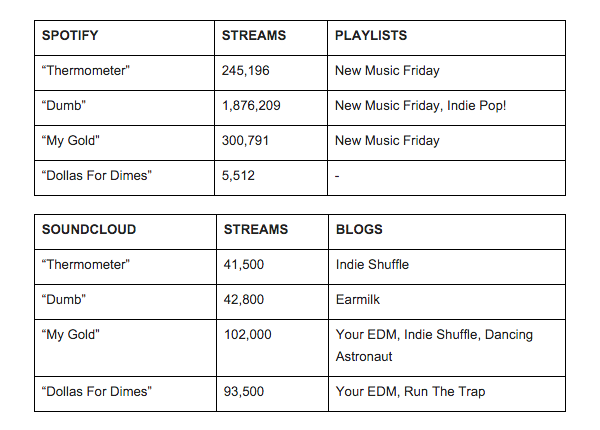1.

Image via Complex
By Melissa Scheinberg
At the start of the “blog age,” music journalism was all over the place. Writers tried their best to be first on the newest releases, blog rolls were of the utmost importance, and there were free MP3s floating all over the internet.
But just a few short years later, the blog landscape is very different. It still helps to be first, but we’re relying on social media presence and exclusivity more than ever. Instead of trying to hit “publish” before your competition, it’s more important to be the first on a new artist to give your site a sense of curation and exclusivity. If we’re all writing about the new Kaytranada remix or Beach House album announcement, what makes one site better than the next?
Our reliance on the internet is ever-increasing, all while the ability to create and release music gets easier and the market becomes further oversaturated. Those whose lives aren’t consumed by music—the casual music fans, those who don’t spend hours a day sifting through music blogs and the depths of SoundCloud—are seeking instant gratification. They’re seeking the easiest, most hassle-free way to find new music.
There will always be a place for music journalism and blog curation, but for casual listeners it’s easier to discover music in a different way: playlists.
Those of us who eat and breathe music also love reading about the music industry, and discovering the newest up-and-coming artists. But the majority of the world isn’t like that. Not to get all Jimmy Iovine here, but while some people enjoy the search for music, most casual music fans (men, too!) are merely looking for the easiest way to find new music to enjoy, prioritizing convenience over discovery.
There will always be a place for music journalism and blog curation, but for casual listeners it’s easier to discover music through something completely different: playlists.
That’s where these curated Spotify playlists come in—and I merely say Spotify and not “collective streaming services” because Spotify got a head start on playlisting. And it also helps, for this article’s sake, that anyone can see a specific song’s stream numbers on Spotify.
Let me demonstrate with a case study: I manage a small Rochester-based band called KOPPS, who—with only a couple thousand Facebook fans, no marketing budget, no label, no publicist—had one million unique Spotify listeners in 2015, which amassed to the equivalent of ten years of music listened-to, mainly thanks to their inclusion in a few significant Spotify playlists.
On the flip side, there are the Soundcloud streams: while the band has had premieres and blog coverage across the board, their total Soundcloud streams currently sit somewhere between 40,000-105,000 for each song, which, as you’ll see below, is a mere fraction of the total Spotify streams for any song selected for a playlist.
Below are two charts illustrating KOPPS’ current number of streams on Spotify and SoundCloud, along with playlist and blog appearances.
3.

There are a few things you can take from this chart. In terms of Spotify, “Dumb” was featured on two separate playlists, hence the high number of plays. “Thermometer” and “My Gold” were featured on New Music Friday (which has over a million followers) for the usual seven days, accounting for the hundreds of thousands of plays. And with “Dollas For Dimes” not being featured on any playlist, we can infer that the playlists get the band all those streams on Spotify. And because our Year In Music analysis from Spotify claims that there were about one million unique KOPPS listeners, we know that listenership was spread through these million—as opposed to a select few listeners streaming their songs hundreds of thousands of times.
Similarly, the band has had plenty of blog coverage. But even on major sites, Soundcloud embed plays only count for a fraction of the total streams across both streaming platforms. So while the music-obsessed are still reading blogs, it seems as though the general public prefers Spotify–along with Apple Music, Tidal, and other streaming platforms–for their music discovery.
This phenomenon is not unique to KOPPS. Countless other new artists—including Transviolet, Pell, and Kevin Garrett—have released music early in their careers that got picked up by Spotify playlists early on, leading to amassed streams very quickly.
So while the music-obsessed are still reading blogs, it seems as though the general public prefers Spotify–along with Apple Music, Tidal, and other streaming platforms–for their music discovery.
While their first song was released a mere six months ago, L.A. four-piece Transviolet has already accumulated over a million unique Spotify listeners from a three-song EP (plus a remix from Twin Shadow). In these six months, the band appeared on Spotify’s New Music Friday, Indie Pop, and Viral 50 playlists. They were pegged as one of Tidal’s “Ones To Watch,” and were played on Apple’s Beats 1 Radio by Zane Lowe and Ellie Goulding. “Playlists were instrumental for us,” explains frontwoman Sarah McTaggart, “they gave people a chance to decide for themselves without all the hype of blogs. What’s beautiful about curated playlists is that they put our music right in front of people who are open to something new.”
Lauded by Spotify as one of their “Predicted Music Stars” for 2015, New Orleans’ Pell has since self-released his stellar debut album, LIMBO, and amassed five million Spotify listeners throughout the year. “I feel like playlists push more to the casual music listener,” he explains, “someone that enjoys music for music, not because of their knowledge about the industry, artist, etc. Exposure is key to the growth of any artist, and with the volume of music increasing year after year, having it be essentially hand-delivered to people through this process is awesome.”
Similarly, singer/songwriter Kevin Garrett has been cosigned by the tastemakers at Spotify, Apple Music, Tidal, and Rdio. Even in his career’s infancy, he’s quickly amassing streams thanks to appearances in the New Music Friday and Alt R&B playlists, and a Zane Lowe Beats 1 premiere. “Streaming has been a pivotal platform for a few reasons,” he explained. “I don’t have any syncs, and while a good number of blogs have shown a lot of love, I’m not blowing up on Hype Machine. From a music discovery perspective, playlists have made my songs so much more accessible to listeners.”
We’ve seen these streaming services derided by bigger names—artists like Thom Yorke, Taylor Swift, The Beatles (until recently), and Prince have withheld their music or spoken out against streaming royalties—and their arguments do make sense. But we often overlook the moments when streaming services look after the little guys, placing lesser-known artists in playlists that reach millions of users daily.
Getting a placement on a coveted Spotify playlist makes way more of a difference—in terms of raw numbers and reach (not engagement)—than blog coverage. How else would Howard Stern have played an unsigned band like KOPPS for his SiriusXM show? Spotify revenue doesn’t begin to approach what you get from digital downloads, but the streams from a New Music Friday feature made for a good amount of money; enough to make up for all of KOPPS’ mixing and mastering fees, with enough left over to fund all gas and hotels during the band’s 10-date tour with Joywave.
We often overlook the moments when streaming services look after the little guys, placing lesser-known artists in playlists that reach millions of users daily.
There is still a caveat. These playlists provide reach and exposure; they provide the ability to get music heard by as many people possible, but they don’t necessarily pick up and keep long-term fans. That’s much more likely on a more personal platform like SoundCloud. If someone does figure out a way to get engaged fans from a platform like Spotify, they will have won the streaming wars.
So what does this mean for the future of the ever-changing music industry? Social media has only recently become a concern for an artist’s management. Servicing songs to playlists will soon follow. Labels and management companies are now hiring “social media managers”—so who’s to say that “streaming manager” won’t become a full-time job?
But there’s still work to do. Transviolet’s Sarah McTaggart made the important point that streaming payouts favor the quantity of plays over the quality of dedicated fans, making the reach from playlisting even more important. “I think streaming is an extremely powerful tool for both fans and artists to connect, but in a world where art is being more and more dangerously devalued, their payment structure has to change,” she said. “If we want a world filled with art, we need to support the artists.”
Streaming payouts favor the quantity of plays over the quality of dedicated fans.
Even with all of this streaming talk, blogs still matter—they will always matter. Blogs provide credibility, and music journalism will remain for those of us who love music and love reading about music. But now that we’ve reached a tipping point, blogs will have to flourish in different ways—curation, exclusivity, events, and even music releases—all while promoting a well-curated group of artists.

